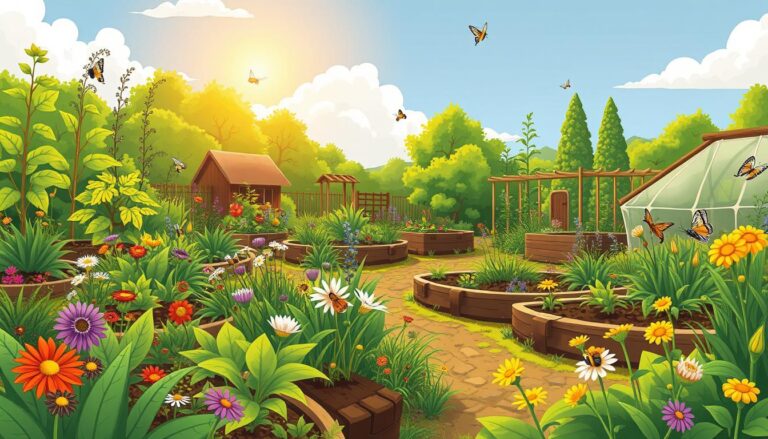Wildlife Corridor Design
In today’s world, wildlife corridors are key to saving our planet. They connect isolated habitats, letting animals find food, mates, and shelter. These paths help animals migrate, support ecosystems, and add to green spaces.
Wildlife corridors are essential in fighting habitat loss. They help animals move between habitats, keeping populations healthy and diverse. Designing these corridors well is important, taking into account the needs of animals and the landscape.
The size and width of corridors matter a lot. They should be at least 1,000 feet wide, with bigger being better. In San Diego County, small habitats under 60 acres often lack native rodents, showing the need for bigger areas and corridors.
It’s also important to keep the area around culverts and underpasses clear. This lets animals move through without getting blocked. For bigger animals, bridges are best, but box culverts at least 12 feet by 12 feet work too.
Key Takeaways
- Wildlife corridors connect isolated habitat patches, enhancing landscape connectivity and supporting biodiversity.
- Effective corridor design must consider the needs of target species, landscape characteristics, and potential human impacts.
- Corridor width should be at least 1,000 feet, with larger widths preferred when possible.
- Vegetative cover near culvert entrances and exits should be maintained without obstructing access.
- Bridged undercrossings are ideal for larger animals, with box culverts measuring at least 12’x12′ as an alternative.
What is a Wildlife Corridor?
Wildlife corridors are strips of land that connect habitats, letting animals move between them. They are crucial for biodiversity conservation. They help species move, keep genes flowing, and support ecological processes in broken landscapes.
Definition and Purpose
Wildlife corridors offer a safe path for animals to travel between isolated habitats. They come in different sizes, from over 500 meters wide to less than 50 meters. Their main goal is to keep populations connected, prevent inbreeding, and help species adapt to environmental changes.
Importance for Ecosystems
Wildlife corridors are key for healthy ecosystems and biodiversity conservation. They let animals move between habitats, keeping genetic diversity high. This reduces the risk of local extinctions and helps areas recover where populations have dropped. They also support urban ecology by providing green spaces for wildlife in cities.
“Wildlife corridors are the lifelines that connect fragmented habitats, enabling species to thrive in an increasingly human-dominated world.” – Dr. Jane Goodall
A Brief History
The idea of wildlife corridors has been around for centuries. Examples include Spain’s livestock drovers’ roads and the European Green Belt. But, serious study and design for biodiversity conservation started in the late 20th century. Now, wildlife corridors are a big part of land use planning and conservation globally, with spatial analysis helping find and prioritize them.
Benefits of Wildlife Corridors
Wildlife corridors are key for animals and ecosystems. They help keep biodiversity alive and prevent species from disappearing. These paths also connect landscapes broken by human activities.
Enhancing Biodiversity
Wildlife corridors let animals move safely between homes. This helps them mix genes and avoid inbreeding. It’s vital for species to stay healthy over time.
These paths also help plants spread seeds and pollen. This boosts the variety of life in ecosystems.
Corridors can stretch for miles, linking places across states and countries. For example, the Christmas Island red crab migration shows how vital these paths are.
Preventing Wildlife Extinction
Habitat loss leads to many species facing extinction. Corridors keep habitats connected, protecting rare species. They give animals the resources they need to live and have babies.
Wetlands, grasslands, and desert oases are crucial for many species:
| Ecosystem | Example | Key Species |
|---|---|---|
| Wetlands | Everglades, Pantanal | Hippos, alligators, manatees |
| Grasslands | Great Plains, Pampas | Bison, lions, elephants |
| Desert Oases | Siwa Oasis | Migratory species in the Middle East, Africa, and Asia |
Promoting Natural Connectivity
Wildlife corridors let animals move between habitats. This is important for ecosystems to stay healthy. They help with pollination, pest control, and more.
They also help ecosystems adapt to climate change. This is crucial for species to survive as the climate shifts.
“In a world where habitats are increasingly fragmented, wildlife corridors offer a lifeline for biodiversity, connecting populations and ecosystems in ways that are essential for their survival and resilience.”
Protecting wildlife corridors is vital for our planet. They support species like red crabs and elephants. These paths are essential for our planet’s health.
Key Factors in Corridor Design
Creating effective wildlife corridors requires careful thought. We must consider landscape features, species needs, and climate changes. These factors help ensure species can move safely and thrive.
Landscape Characteristics
The landscape around a corridor is key. It affects how easy or hard it is for species to move through. Patches that run perpendicular to the corridor catch more species, boosting diversity.
Circular patches are better at keeping resources safe inside. They support more habitat preferences than rectangular ones.
Wildlife Species Needs
It’s important to choose many species for corridors. This way, no species is left out. Knowing how species move and live is crucial for good corridor design.
Roads can be a big danger. Slowing down traffic helps keep species safe in and around corridors.
| Corridor Attribute | Importance |
|---|---|
| Matrix | Affects hostility or penetrability for species |
| Patch Orientation | Perpendicular patches catch more species |
| Patch Shape | Circular patches protect internal resources better |
| Network Connectivity | Influences animal movement between patches |
Climate Considerations
Corridors should be designed with climate change in mind. This helps species adapt by linking habitats now and in the future. Using complex terrain and climate refugia helps with this.
Buffer zones around corridors reduce edge effects. This keeps the area’s ecological balance.
Guidelines suggest a road and motorized trail density of generally less than one-half mile per square mile within wildlife corridors to maintain ecological integrity.
By studying corridor features and species needs, we can design better corridors. This is a team effort. It aims to connect habitats and help wildlife move through broken landscapes.
Case Studies of Successful Wildlife Corridors
Wildlife corridors are key in saving biodiversity and reducing habitat loss. They connect isolated areas, letting animals roam freely. This helps them find food, mates, and keeps their gene pool diverse. Let’s look at some successful wildlife corridors from around the world.
Yellowstone to Yukon Conservation Initiative
The Yellowstone to Yukon (Y2Y) Conservation Initiative is a big project. It aims to link protected areas from Yellowstone National Park to the Yukon Territory. This covers over 2,000 miles of different landscapes.
This initiative protects important habitats for animals like grizzly bears, wolves, and caribou. It helps these animals move, keeping their gene pool healthy and preventing local extinctions.
Florida Wildlife Corridor
The Florida Wildlife Corridor is a statewide effort to protect Florida’s natural areas. Florida has lost a lot of habitat to urbanization. This corridor aims to connect the Everglades, the Ocala National Forest, and other key habitats.
One main goal is to save the Florida panther, a critically endangered subspecies. By linking panther populations, the corridor prevents inbreeding. This increases the panther’s chances of survival.
The M32 Green Bridge in the UK
The M32 Green Bridge in Bristol, UK, is a unique example of urban wildlife corridor design. It’s a vegetated bridge over a busy motorway. It lets wildlife cross safely without getting hit by cars.
The bridge is covered in native plants, attracting birds, bats, and small mammals. It shows how wildlife corridors can work in cities.
These examples show how vital wildlife corridors are for biodiversity and ecological connections. By studying these successes, we can create effective wildlife corridors in other areas facing similar issues.
Challenges in Wildlife Corridor Implementation
Setting up wildlife corridors is tough. One big problem is human-wildlife conflicts. This happens when people and animals meet in areas where nature is being pushed out by development. But, well-made corridors can steer animals away from people, cutting down on accidents and damage.
Another big challenge is land use conflicts. Corridors need land that could be used for farming, building, or mining. Finding a balance between saving nature and meeting human needs is hard. Working together is key to solving these problems and making corridors work.
Money and resources are also big hurdles. Buying and fixing land for corridors costs a lot, especially in pricey areas. With not enough money, it’s hard to do big conservation projects. So, we need to pick the most important corridors first.
Balancing Human Development and Wildlife Needs
To overcome these challenges, we need to find a middle ground. This means careful planning and thinking about many things. For example:
- Identifying critical habitat areas and movement routes for target species
- Assessing the potential impacts of human activities on wildlife populations
- Engaging stakeholders, including local communities, in the planning and decision-making process
- Developing strategies to minimize human-wildlife conflicts, such as public education and appropriate land use policies
By working together and being proactive, we can find ways that help both animals and people. For instance, creating buffer zones around corridors can reduce conflicts. It also opens up chances for eco-tourism and other green jobs.
Economic Considerations and Conservation Action
The cost of making wildlife corridors is a big issue. But, it’s worth it in the long run. Corridors keep nature diverse and healthy. They also give us important services like clean air and water, and help fight climate change.
| Ecosystem Service | Economic Value (per year) |
|---|---|
| Pollination | $235-577 billion |
| Carbon sequestration | $400 billion |
| Water regulation | $2.3 trillion |
By looking at the economic value of these services, we see that corridors are a smart investment. They’re good for the planet and for our wallets. Also, focusing on the most important corridors helps us use our resources wisely.
“The challenge is to find ways to maintain connected wildlands in the face of increasing development pressure and human population growth. We need to act now, before it’s too late.”
– Dr. Michael Soulé, conservation biologist
In conclusion, making wildlife corridors is hard, but it’s doable. We face challenges like conflicts, land use, and money issues. But, with teamwork, science, and careful planning, we can make sure both wildlife and people can live well in connected, strong landscapes.
Best Practices for Effective Design
Creating effective wildlife corridors needs a team effort. It involves local communities, experts from different fields, and ongoing checks. This way, we can make sure both wildlife and people benefit from these corridors.
Community Involvement
Getting local communities involved is key to wildlife corridor success. By visiting the field and talking to experts, we learn a lot. This helps us make better maps and choose the best paths for wildlife.
Interdisciplinary Collaboration
Designing corridors well needs a team of experts. This team includes ecologists, wildlife biologists, urban planners, and engineers. They work together to make sure the corridor works for both animals and people.
- Ecologists know what animals need and how they move.
- Wildlife biologists study how corridors affect animals.
- Urban planners make sure the corridor fits with the area’s plans.
- Engineers build safe paths for animals to cross.
Monitoring and Evaluation
It’s important to keep checking how well corridors work. We track things like animal movement and how the area changes. This helps us make the corridors better over time.
| Indicator | Purpose |
|---|---|
| Animal movement and behavior | See if the corridor helps animals move as planned |
| Population dynamics | Watch how animal numbers and where they live change |
| Habitat quality | Check how the area’s plants and trees change |
| Human-wildlife interactions | Find and fix problems where animals and people meet |
By looking at data often, we can make the corridors work better. Over 300 plans to save land for ecological corridors have been made and started around the world. This shows how important it is to keep checking and improving these areas.
Future Directions in Wildlife Corridor Design
Looking ahead, several key areas will shape the future of wildlife corridor design. Advanced GIS modeling is being used to design corridors on a larger scale. This considers the complex nature of different landscapes. These tools help plan corridors more precisely, meeting the needs of various wildlife species.
Policy and advocacy efforts are also crucial. Strengthening laws and securing funding are essential for corridor success. Community involvement in planning is vital, ensuring corridors fit local needs. Collaboration among experts will lead to sustainable corridor solutions.
Integrating Corridors into Urban Planning
As cities grow, it’s important to include wildlife corridors in urban planning. Urban greenways offer a way to keep habitats connected in cities. By designing these greenways as corridors, we help wildlife move through cities.
This not only helps wildlife but also improves city life. It gives residents access to nature and fun activities.
Monitoring and Adaptive Management
Monitoring and adjusting corridor management are key to their success. Regular assessments and strategy changes ensure corridors work as intended. New technologies like remote sensing and GPS tracking help track wildlife and corridor performance.
Using these tools in management boosts conservation efforts. It makes the most of limited resources, maximizing impact.
Source Links
- C:\Inetpub\wwwroot\Programs\sprawl\wild-corridors.prn.pdf
- Corridor Ecology: Linking Landscapes for Wildlife Conservation – Ecological Landscape Alliance
- Wildlife corridor
- Wildlife Corridors 101: Everything You Need to Know – EcoWatch
- Wildlife Corridors
- Wildlife Corridors – Explanation, Examples & Benefits
- The Road to Recovery: How Wildlife Corridors are Smart Economic Investments – Center for Large Landscape Conservation
- Microsoft Word – WorkshopBook.doc
- Recommended Wildlife Corridor Goals and Objectives
- Frontiers | Urban wildlife corridors: Building bridges for wildlife and people
- Wildlife corridor creation – (Conservation Biology) – Vocab, Definition, Explanations | Fiveable
- What are Wildlife Corridors? (Answer Inside)
- What are the Pros and Cons of Wildlife Corridors
- Toward Best Management Practices for Ecological Corridors
- Microsoft Word – BMPs.doc
- Design Considerations for Wildlife Crossings
- If You Build it, Will They Come? Wildlife Corridors Need Smarter Design
- Conservation Evidence – Scientific Papers | Saving Nature







